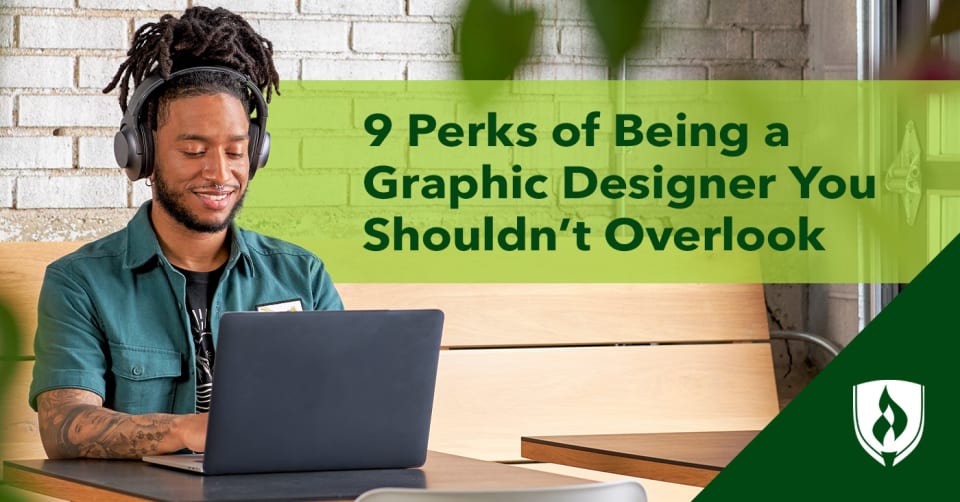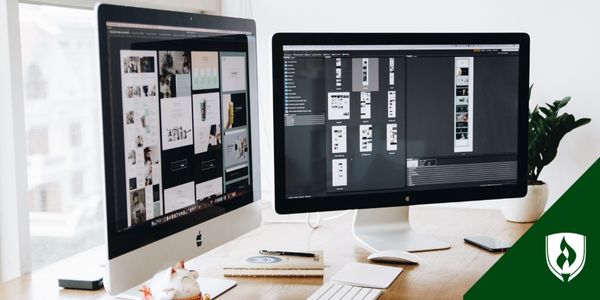
You’ve always been naturally creative. You were the one getting in trouble in grade school for doodling illustrations on your math homework instead of paying attention to the long-division problem on the chalkboard. As you got older, it’s more than likely that you excelled in art class—and not only that, but you also enjoyed it!
If you’re considering becoming a graphic designer, you’ve picked an excellent career to mull over. Graphic designers create visual concepts to communicate ideas that inspire and inform customers. They generally use computer software, but many graphic designers are pretty handy in the drawing department as well. Graphic designers can also advance to become art directors and creative directors, positions that come with greater creative oversight and a higher salary.
There are plenty of perks that come with being a graphic designer—both job-related and lifestyle related. So what’s in store for you if you choose this career path? Are the benefits of this job the type of advantages you’re looking for? Read on to learn more about the bonuses that come with being a graphic designer.
8 perks of being a graphic designer
Whether big or small, these benefits to working in graphic design shouldn’t be overlooked. Read on to learn more about some of the potential positives.
1. Your employment isn’t tied to just one industry
Companies across a huge variety of industries need to promote their brands. This means that they need logos, brand guidelines and tons of other important visual materials to support them. This means there’s plenty of opportunity to work for clients across a wide variety of industries—one day you may be whipping up a promotional poster for a charity event and the next you could be working on a logo for a healthcare company.
If you’re the kind of person who has a wide range of interests and is always itching to learn something new, graphic design could provide the right outlet for you, allowing you to learn about what makes different industries tick. Paula Glynn, business coach and director of search marketing and digital strategy, loves how working within different industries keep her inspired. “I always learn something new from my clients and it has helped me grow as a designer and as a person,” she says.
Adding to this potential variety is the huge market for web graphics. No matter the industry, a website and social media presence are essential for developing a brand—which means plenty of potential project sources for graphic designers.
2. You can work in multiple environments
The way work comes to graphic designers is pretty unique. You may find yourself as part of a small, in-house team working strictly for a single client or in a fast-paced agency environment that works with multiple clients with their own distinct visual feel. Freelancing is also an option for designers who would like to tap into their entrepreneurial spirit from the comfort of home. Each of these work environments have their pros and cons, so be sure to read up on the differences.
3. You can choose to be self-employed
Not only can you work in a variety of environments, but also many designers find that they prefer to be their own boss and choose to start their own freelance business. Not only does this mean you can work from home or your local coffee shop, but it also means you can set your own prices and hours.
Keep in mind, however, that with the freedom of self-employment comes the responsibility of all the administrative work that comes with being your own boss: sending invoices, following up with clients, setting aside money for taxes and more. It might not be for everyone, but many do find this trade off completely worth the extra administrative work. “Navigating the business side of design has pushed me to be more resourceful, resilient and more conscious of my clients’ needs and business goals. The payoff is well worth the effort,” says independent designer and art director Cathylynne Ahlgren.
4. You have many specialties to choose from
Graphic designers can specialize in a certain type of design if they’d like: typography, web design, illustration, user experience design, 3D packaging and more. Others limit themselves by only using one palette or specific materials.
A specialization will make you an in-demand team member or freelancer; however, if you’re skilled in a variety of these areas, your versatility can help your employability.
5. It’s not boring
When it comes to graphic design, there are always new technologies and trends to learn. Style and aesthetic change so quickly in American culture, and technology shifts and evolves just as quickly. If you want to stay relevant, it’s essential to keep up with the times and make sure you’re ready for whatever is up and coming. Having a curious mind and a teachable spirit will take you a long way in this profession.
Each day you work is different. One of the things that Matthew Paton, former graphic designer and current founder of Hypernia, liked most about design was how unique each day was. From presenting your designs to eager clients to brainstorming your next design, he was hardly ever bored. “It’s hard to find a job that provides such variety to everyday life”.
6. You can express yourself
Designers get to express their creativity on a regular basis—it’s the essence of the job! You’ve got plenty of creative ideas and concepts you’d like to experiment with, and this job allows you to give them a chance. While your clients’ needs will likely still keep some of your more extravagant creative impulses in check, it’s still satisfying to create something visually appealing and unique to you.
“Clients don’t often know what they want until they see it. It’s my job to translate their ideas into a design and love that,” says Ahlgren.
Many graphic designers considered becoming artists early in their careers, but find that they get more eyes on their work and more consistent work as a graphic designer.
“I was originally a fine art major, but quickly realized that art for art’s sake was boring,” says Richard Williamson, chief marketing strategist at Citizens High School. “I love to draw and paint, but in reality, that affects such a small number of people that it’s almost like talking to yourself. Graphic design, however, is at the heart of everything that goes on in our culture: television, news, the internet, education, advertising.”
7. You can create things for yourself, friends and family without having to outsource
Chances are good that, at some point, someone in your circle of friends and family will need a logo, t-shirt design, website or some other design venture that you could be able to help out with. Through your design skills, you won’t need to hire someone to create your wedding invitations or design your business logo—your skills make you a built-in bonus for those around you.
Jeff Greenhouse, vice president of subscriber growth at AMC Networks, says he’s been able to put his design skills to use outside of work frequently.
“As a parent, I get to constantly amaze my children by creating custom designs for their birthdays, special occasions or fun projects at home,” Greenhouse says. “As a member of my community, I have volunteered my design skills to help out with various initiatives.”
Be careful not to let people take advantage of you, however. There’s a time and place for favors, but if someone is repeatedly coming to you for work you could make money doing, you’ll need to set some boundaries.
8. You have concrete proof of your abilities
One overlooked, yet appealing aspect of being a graphic designer is that the job is absolutely a “show me” career. You can display your best work in a portfolio to calm many of the concerns a potential client may have about your abilities. Having tangible proof of your abilities is an asset—for instance, accountants can’t really showcase their ability to handle complex tax law. Graphic designers have the ability to prove their skills—which puts the power in your hands. If you want to show you’ve got a knack for typography, you can create examples instead of trying to list it as a bullet point on a resume.
Plus, it’s gratifying to see your work come to life whether it’s a website or on a supermarket shelf. “It’s very satisfying to see something that was once an idea come to fruition,” says Dennis Lenard, CEO of Creative Navy.
9. You’ll always be collaborating
While sitting on your own and designing may seem like a lonesome task, you’ll always be collaborating with both the client and other creative individuals through the design process. You’ll get to know your client well and develop a rapport and a rewarding relationship with them.
Plus, you’ll work with copywriters, developers, and other creative professionals. Hearing their insights will help you create a better design. Their ideas may even inspire you. “Each person brings a valued skill to the table,” says Ahlgren.
But is it worth it?
Now that you’ve read about some of the perks of being a graphic designer, it’s probably just as clear to you as it is to us: This creative profession has a lot going for it.
If you’re considering what it might mean to begin a career in graphic design, take some time to read more first-hand advice from creative professionals in our article, “How to Become a Graphic Designer: Career Advice from Creative Pros.”




